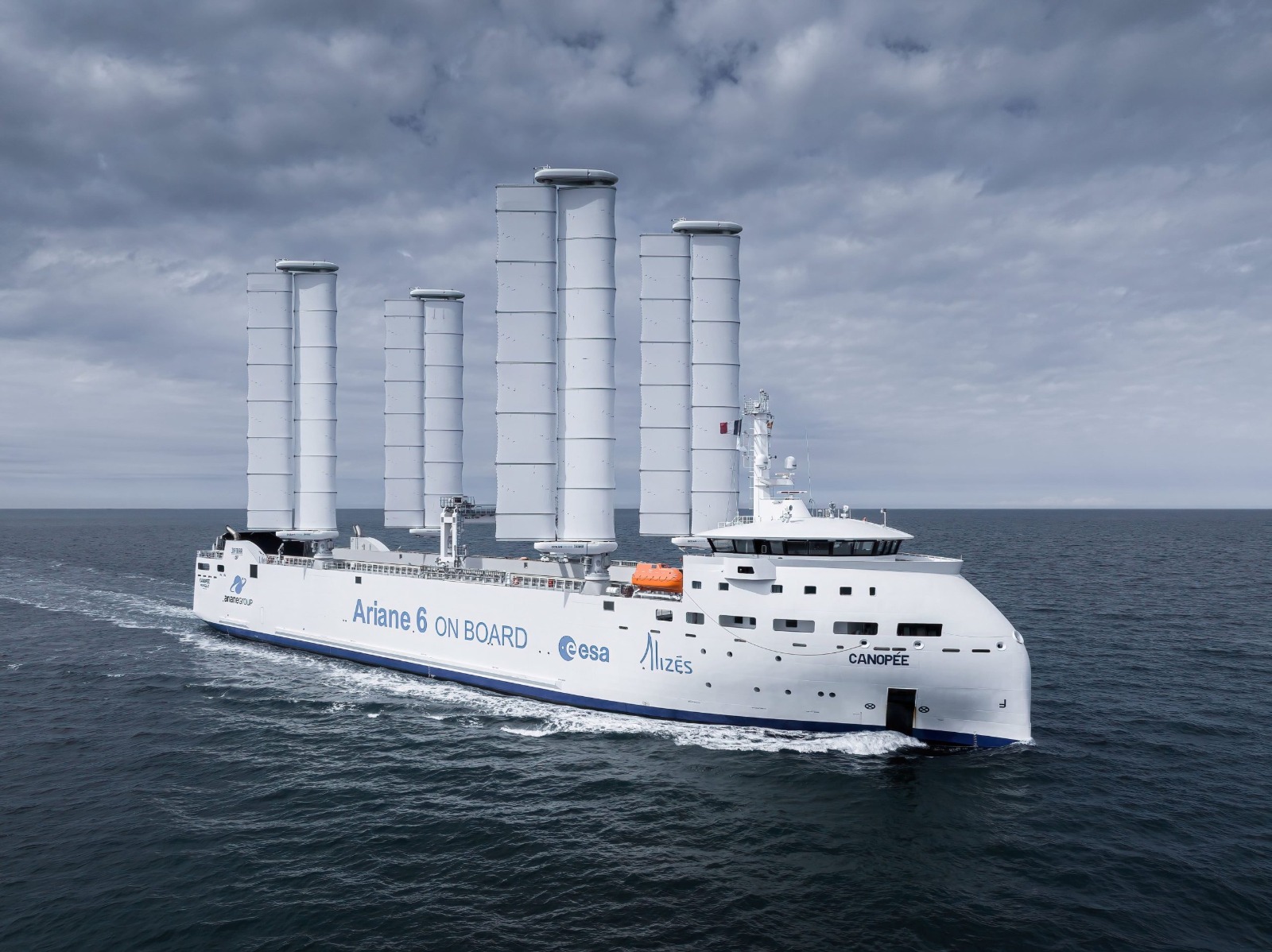The European Space Agency is preparing to launch its latest and largest space rocket, the Ariane 6, in mid-2024. What makes this endeavor intriguing is the agency’s utilization of a wind-powered cargo ship to transport rocket components to the launch site in French Guiana.
Canopée, recognized as the pioneering hybrid industrial vessel featuring collapsible wing sails, stands out as a cargo ship with a distinctive design and an exceptionally unique payload.
With four sails towering at a height of 121 feet (37 meters) above its main deck, Canopée utilizes wind power by capturing it through its expansive sails, which collectively cover an area of nearly 16,000 square feet (1,486 square meters).
While Canopée currently relies on a pair of diesel engines as its primary power source, its design represents a preview of the future of shipping.
The remarkable “Oceanwings,” named for their resemblance to fully deployed aircraft wings, hold the potential to slash fuel consumption by up to 50 percent.
In early November, Canopée achieved a significant milestone by completing its first transatlantic voyage. During its maiden transatlantic journey with sails deployed, Canopée transported critical components of the upper section of the Ariane 6 launcher.
This cargo included the fairing and components of the boosters, all intended for the inaugural flight. These crucial parts were unloaded and delivered to Europe’s Spaceport in Kourou after the crossing.
The rocket, constructed in facilities across Europe, requires transportation of its components to the European Space Agency’s spaceport in French Guiana. This overseas territory of France is located in the northeast of South America.
Canopée has been purposefully constructed to fulfill the complex demands of transporting Ariane 6. As a hybrid-propulsion vessel, it is specifically designed to simultaneously transport all the stages and sub-assemblies of the launcher.
Nils Joyeux, the managing director of Alizés, the French company operating the ship, explained that they can achieve fuel savings of up to 50% or 60% under optimal wind conditions. However, these savings may be reduced to around 10% or 15% in less favorable instances.
“At the moment, we’re expecting to save around 30% on average, but we’ll need a few more years of operation to confirm this projection,” Joyeux added.
Joyeux expresses unwavering confidence in the increasing competitiveness of wind energy in the upcoming years. He emphasizes that while it may not represent the complete solution for decarbonizing the shipping industry, it’s an indispensable component that cannot be overlooked any longer.
Reflecting on the initial idea of reintroducing sails to cargo ships a decade ago as a bold move, he now sees it as a significant aspect of the future, especially as numerous shipping companies are considering similar approaches.
Canopée Cargo Ship
The construction of this unique vessel spanned six years, with its primary purpose being the transportation of components for the European Space Agency program to the launch site in French Guiana, South America.
The vessel was specifically designed to meet the rigorous requirements of the ArianeGroup overseeing the space program and to address the challenges posed by the port of Pariacabo in French Guiana.
A crucial aspect of the vessel’s design was addressing the maritime challenges posed by shallow waters and the narrow Kourou River, ensuring its capability to navigate these conditions while efficiently transporting its cargo.
Neptune Shipyard in Poland constructed the vessel completed in time for its maiden trials in December 2022.
Embarking on a test voyage on December 27, 2022, the ship traversed from Bremen, Rotterdam, and Le Harve to Bordeaux en route to the South American launch site.

After the sail installation was completed in July, the vessel underwent extensive dock and sea trials to ensure its seaworthiness and operational readiness.
The vessel is contracted to make up to 12 crossings annually. Under a 15-year agreement, the ship is committed to supplying components for the Ariane 6 space program.
The European Space Agency manages and financially supports this initiative, signifying a long-term commitment to space exploration and transport.
The vessel exhibits a remarkable capacity to transport 5,000 tons of cargo while maintaining a speed of 16.5 knots. The flexible “Oceanwings,” crafted from sailcloth and affixed to Canopée, allow the crew to adjust the sails’ height along the mast directly from the ship’s bridge.
- Contact the author at ashishmichel(at)gmail.com
- Follow EurAsian Times on Google News




